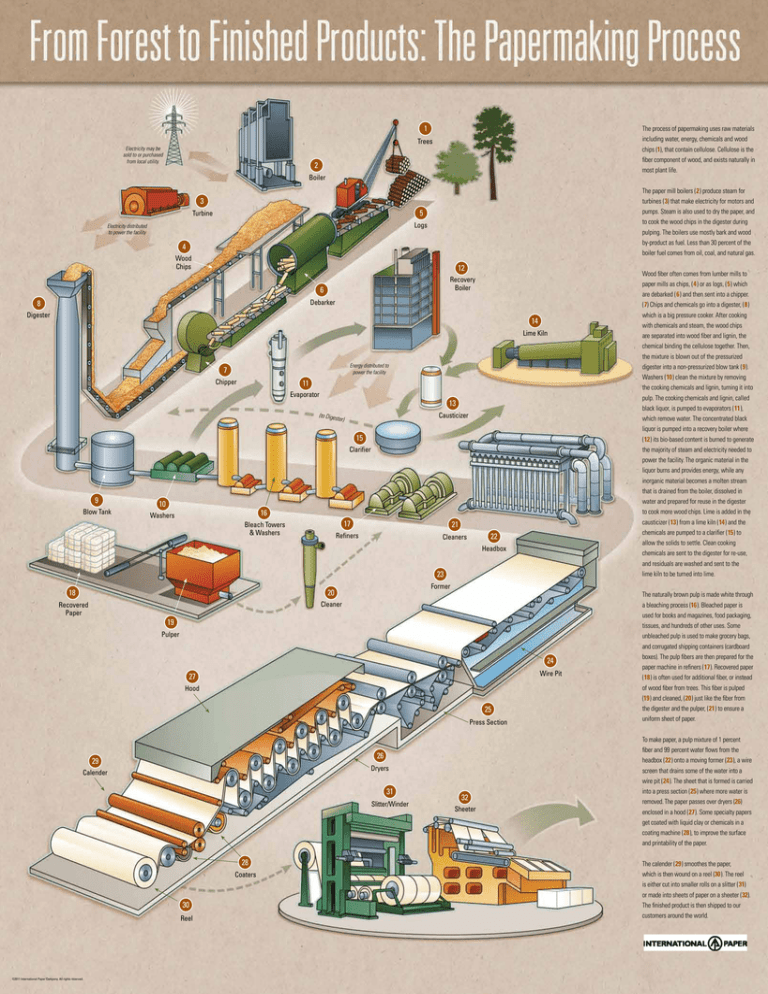
1
The process of papermaking uses raw materials
including water, energy, chemicals and wood
chips (1), that contain cellulose. Cellulose is the
fiber component of wood, and exists naturally in
most plant life.
Trees
Electricity may be
sold to or purchased
from local utility.
2
Boiler
The paper mill boilers (2) produce steam for
turbines (3) that make electricity for motors and
pumps. Steam is also used to dry the paper, and
to cook the wood chips in the digester during
pulping. The boilers use mostly bark and wood
by-product as fuel. Less than 30 percent of the
boiler fuel comes from oil, coal, and natural gas.
3
5
Turbine
Logs
Electricity distributed
to power the facility
4
Wood
Chips
12
Recovery
Boiler
6
Debarker
8
Digester
14
Lime Kiln
Energy distributed to
power the facility
7
Chipper
11
Evaporator
13
Causticizer
(to Diges
ter)
15
Clarifier
9
Blow Tank
10
16
Washers
Bleach Towers
& Washers
17
21
Refiners
Cleaners
22
Headbox
23
18
20
Recovered
Paper
Cleaner
Former
19
Pulper
24
Wire Pit
27
Hood
25
Press Section
26
29
Dryers
Calender
31
Slitter/Winder
28
Coaters
30
Reel
©2011 International Paper Company. All rights reserved.
32
Sheeter
Wood fiber often comes from lumber mills to
paper mills as chips, (4) or as logs, (5) which
are debarked (6) and then sent into a chipper.
(7) Chips and chemicals go into a digester, (8)
which is a big pressure cooker. After cooking
with chemicals and steam, the wood chips
are separated into wood fiber and lignin, the
chemical binding the cellulose together. Then,
the mixture is blown out of the pressurized
digester into a non-pressurized blow tank (9).
Washers (10) clean the mixture by removing
the cooking chemicals and lignin, turning it into
pulp. The cooking chemicals and lignin, called
black liquor, is pumped to evaporators (11),
which remove water. The concentrated black
liquor is pumped into a recovery boiler where
(12) its bio-based content is burned to generate
the majority of steam and electricity needed to
power the facility. The organic material in the
liquor burns and provides energy, while any
inorganic material becomes a molten stream
that is drained from the boiler, dissolved in
water and prepared for reuse in the digester
to cook more wood chips. Lime is added in the
causticizer (13) from a lime kiln (14) and the
chemicals are pumped to a clarifier (15) to
allow the solids to settle. Clean cooking
chemicals are sent to the digester for re-use,
and residuals are washed and sent to the
lime kiln to be turned into lime.
The naturally brown pulp is made white through
a bleaching process (16). Bleached paper is
used for books and magazines, food packaging,
tissues, and hundreds of other uses. Some
unbleached pulp is used to make grocery bags,
and corrugated shipping containers (cardboard
boxes). The pulp fibers are then prepared for the
paper machine in refiners (17). Recovered paper
(18) is often used for additional fiber, or instead
of wood fiber from trees. This fiber is pulped
(19) and cleaned, (20) just like the fiber from
the digester and the pulper, (21) to ensure a
uniform sheet of paper.
To make paper, a pulp mixture of 1 percent
fiber and 99 percent water flows from the
headbox (22) onto a moving former (23), a wire
screen that drains some of the water into a
wire pit (24). The sheet that is formed is carried
into a press section (25) where more water is
removed. The paper passes over dryers (26)
enclosed in a hood (27). Some specialty papers
get coated with liquid clay or chemicals in a
coating machine (28), to improve the surface
and printability of the paper.
The calender (29) smoothes the paper,
which is then wound on a reel (30). The reel
is either cut into smaller rolls on a slitter (31)
or made into sheets of paper on a sheeter (32).
The finished product is then shipped to our
customers around the world.
